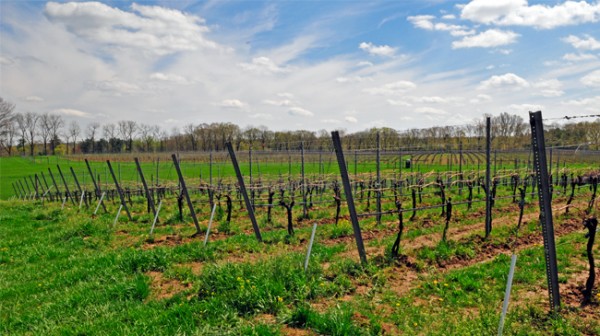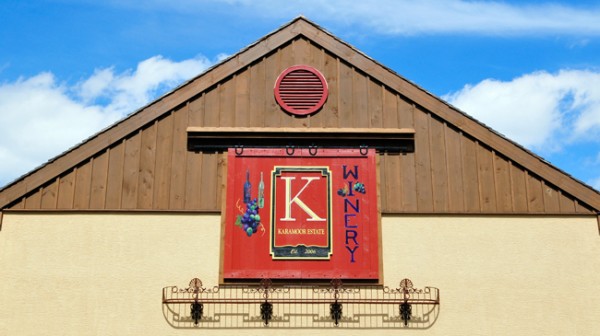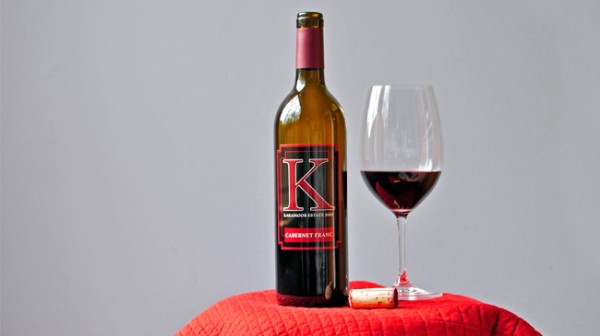
The mundane led us to a fantasy. Residing behind a nondescript gate along an ambling road in the out-of-the-way Philly suburb of Blue Bell was the most marvelously well-heeled winery in the land. Reports made mention of a Wonderland-like spread, a majestic, farm country estate with sprawling spaces of green lawn and meticulously manicured orchards. Mansions decorate corners of the plot and swans swim languidly in ponds as the breeze plays through the leaves. From a road lined by shade trees, the eye floats easily to acres of grape vines plotted with draft-master precision. A gleaming winemaking facility lies adjacent to the vineyard, and from its tanks flow gallons of some of the most celebrated wines of the region.
The master of the land is a “private man” who operates from behind the hedgerows, only occasionally granting outsiders access to his domain. So went the steady refrain describing wealthy businessman and philanthropist Nicholas “Nick” Karabots. The best we understood, Karabots had a passion for good wine and was willing to mine his deep pockets to perfect a better PA product. Validation of Karabots’s commitment, aside from the high-end winery, was the import of a veteran California vintner to man the controls. Napa in the land of Wawa. Was this fantasy or some sort of warped reality?
Over time, Pennsylvania wine enthusiasts took notice of Karabots and news of his fledgling Karamoor Estate. How could they not? At PAVC, we were no exception. We wanted a fuller understanding of the enigmatic operation, especially after tasting the occasional glass of the winery’s Chardonnay or red blend. In fact, Mike and I spent weeks trying to gain entry. Weeks. The wait made it easy to wonder if, after all, the place even existed.
We can now report that yes, it does exist – every speck of it – and, chances are, you’ll never see it.
On an early spring morning, having been finally approved for entry, we waited alongside the road at the Karamoor entrance. After buzzing in, we were told to wait. A few minutes passed. Then, slowly, the gate eased open. We peered in, half expecting a wide-eyed man to limp forth on his cane, adorned in purple velvet jacket and top hat, asking us to produce a golden ticket.
It was winemaker Kevin Robinson, as it turned out, who appeared as our decidedly normal host, sitting behind the wheel of a pickup truck. With a smile spread across his face, he waved us toward the winery.

“If you asked me a few years ago, ‘Hey can you see yourself making wine in Philadelphia?’” Robinson laughed, creating echoes across the still, empty winery as we entered. “Are you kidding me? I really didn’t have a clue…I always felt sorry for those poor guys that had to make wine out here.”
A former military brat and 35-year resident of California, Robinson graduated from UC Davis before moving on to a two-decade stretch at Rutherford Hill and Brassfield Estate. His background extends across grapey stomping grounds from Sonoma and Napa to Mendocino where he learned from industry standard bearers like David Ramey.
Why in the world would a young vintner, nearing the height of his arc, leave wine’s dreamland for the infernally confounding ground of the Right Coast? “Having gone through a season now, I can really respect (Northeast vintners), because it’s tough,” he reflected. “You’ve got more rain than I’ve ever seen, humidity, bugs – bugs I never even knew existed before.”
The real reason for Robinson’s career turn traces to Nick Karabots. By all accounts, Karabots is a man who is compelled by (and accustomed to) success, and it’s not difficult to imagine him making the California winemaker an offer he couldn’t refuse. Of the winery, Robinson admits he wants for nothing, confirming it’s “state-of-art everything – very well thought-through.”
Wines under the Karamoor label, using grapes grown on the Karabots estate in 2008, were first produced at Allegro Winery in Brogue, under the guidance of Carl Helrich who stewarded the program through the 2010 harvest. Robinson’s first season was 2012, and he stepped directly into the challenge. He had no choice.
“The fruit, we throw everything at it, we stay on top of the viticulture – we have to – and still you’re going to have suspect fruit,” he said. “The rots, the mildews, the molds – everything wants to just grow here like a greenhouse.”
Then there are the wild fluctuations of temperature. Earlier this year, March brought 80-degree days, lulling the Karamoor crew into a false sense of security, before a crushing April frost killed off three-quarters of the estate’s Chardonnay and 45% of its overall yield. “Just fried,” Robinson recalled. Surprisingly, the surviving grapes showed strong promise. “This is what nature, what God gave us to make wine this year,” he went on. “And hell if it didn’t turn out great…I’m amazed.”
Difficult conditions call for commensurate measures, said Robinson, and the winery will chaptalize, if needed, to push wines to the desired alcohol levels – 13 to 13.5% – and balance. Powdered tannins are also employed when necessary. “We lack that a little bit here, that structure. You need that age-ability,” he said.
When asked if Pennsylvania fruit is blessed with positive qualities, Robinson jumped in before hearing the end of the question. “Absolutely. What I like here is the restrained delicacy and elegance of the wines. (In California), it’s just fruit bomb, big powerhouse, big alcohol, get the fruit really ripe.”
Karamoor currently bottles Merlot, Chardonnay, Cabernet Franc and their flagship wine, a Meritage drawn from Cabinet Franc, Merlot, Cabernet Sauvignon and Petit Verdot – all of which Robinson poured as we stood in a small lab at one end of the facility, chatting about the formation of the estate.
“Mr. and Mrs. Karabots fell in love with vineyards while traveling through Europe,” the winemaker said, explaining that little success came from a variety of crops that were previously planted on the Blue Bell property. “(Nick) planted everything out here from wheat, barley, alfalfa, sorghum – whatever it was. He lost money on every one he said he ever did. (He decided), ‘If I’m going to lose money I might as well do something I like.’”
The vines at Karamoor are very young, having been planted in 2004 (12.5 acres) and 2008 (4.5 acres). Ten additional acres were added this year, featuring about 35% Cabernet Sauvignon and 40% Sauvignon Blanc. “I thought this program needed another white, keeping with the Bordeaux theme,” Robinson said. Viognier, Malbec and Pinot Grigio are also being added.
Our tasting was humming along. We sampled 2008 bottlings alongside the 2010 versions of Meritage, Merlot and Cab Franc, all of which were released this past July. Of the earlier vintage, the Merlot showed good structure and an earthy, tobacco quality that stood up well. The 2008 Cabernet Franc was also richly earthy, slightly vegetal and well-structured, with tannins and a complexity that Robinson felt was “kicking ass.” He went on to say, “I think the Franc is some of best I’ve ever had. Anywhere.”
The winemaker repeatedly praised the quality of the 2010 reds, and the Meritage didn’t contradict his point. We then ventured into the barrel room where he poured samples from the still-aging 2012 lineup. We loved the nose on the Cab Franc, which displayed rich, dark fruit and intriguing bell peppery notes. When it came to aroma, though, nothing could touch the Meritage which could have been picked up from across the room. Mostly Merlot, followed by (in descending order) Cab Sauv, Cab Franc and Petit Verdot, it’s a very desirable blend with grippy tannic structure and satisfying, deep fruit.
With face pushed close to his glass, Robinson admired his work and noted, “I’m not a big oak guy.” His declaration was unnecessary, though, as the 2012 wines had already confirmed this.
Finding Karamoor is increasingly easier now that the PLCB carries the wines at about a dozen Philadelphia area stores. “They’re very supportive,” Robinson said. The winery’s list of restaurant and wine bar accounts continues to expand to cover a lineup including Vetri and Garces restaurants, Tria, Jet Wine Bar, Vino Volo and craft breweries. Victory Brewing in Downingtown, Robinson noted, “is doing really well selling bottles.”
“There’s never going to be – probably – a tasting room on this property,” he went on, noting that the idea of establishing a retail space in the immediate area is being kicked around. New York and New Jersey channels are also being examined, and other parts of Pennsylvania might become a later push.
As another priority, the Karamoor team has focused on selling keg wine and has built up a cadre of on-tap accounts in Philly and the burbs: Alla Spina, Chambers 19, Earth Bread + Brewery, Forest & Main Brewing Company and The Stone Rose. The keg wines feature vintages leading up to, but not yet including, 2010. Robinson noted that the 2009 and 2011 vintages, which were “not up to standards,” may be declassified and used for keg and bulk sales.

With his own handiwork edging up to the production line (of the 2012 wines, the Chardonnay should be ready for market by end of year and the reds, to be bottled in early 2014, will likely be sold by fall), Robinson seems staunchly optimistic about the future. “(It’s) the fact that we’re local and people want to see something good local,” he said. “They’re willing to support it.” When asked about Karamoor’s competitors, he rattled off expected area players – Penns Woods, Briar Valley, Allegro – before qualifying that, realistically, wine from every region of the world is competition: “I was taught by (importer/producer) Anthony Terlato years ago…always aim high. Never settle for being just better than your neighbor because we’re on a world stage here.”
Pennsylvania on the world stage? The notion would be unbearably audacious if it weren’t so refreshing, and I was happy to hear a seasoned winemaker speak confidently about the upside of local wines. “This state is only going to get better.” Like California when he started his career. “We’re in our infancy. We’re just getting started trying to figure out who we’re going to be and how we’re going to do this.”
Somehow, it didn’t sound like a fantasy.